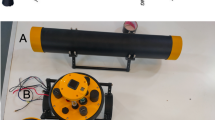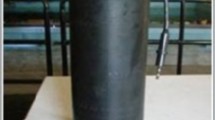Abstract
Autonomous Underwater Profiling Drifter (AUPD) is developed by National Institute of Ocean Technology (NIOT), Chennai, India, for the vertical profiling of the ocean. AUPD is a free-drifting profiling platform for near real-time in-situ observation of the upper 2000 m of the ocean column. It measures conductivity and temperature profiles with reference to depth. The AUPD transmits measured data through ARGOS satellite Platform Terminal Transmitter (PTT) to ARGOS regional centre as per the requirement of the International ARGO program. The AUPD ascends or descends due change in buoyancy (±250 cm3). While on sea surface (to transmit the profile data), the position of the float is derived using the Doppler shift method with an accuracy of ~100 m. NIOT developed AUPD and deployed in the Arabian Sea in 2013–2015. The AUPD is ballasted for a pre-deployment depth of 2000 m and pre-programmed for a typical profiling cycle of 2 days. The AUPD is designed with 32 bit Atmel micro-controller and a lithium battery bank provides power. It has endurance for 150 profiles. AUPD float is suitable to fulfil the demand for profiling floats for International Argo Program. This paper is focused on the development of AUPD. The paper also discusses testing and field deployment of AUPD float.














Similar content being viewed by others
References
Andre X, Le Reste S and Rolin J-F 2010 Arvor-C: A coastal autonomous profiling float; Sea Technol. 51(2) 10–13.
Boebel O, Schultz Tokos K L and Zenk W 1995 Calculation of salinity from neutrally buoyant RAFOS floats; J. Atmos. Ocean. Technol. 12 923–934.
Davis R E, Regier L A, Dufour J and Webb D C 1992 The autonomous Lagrangian circulation explore; J. Atmos. Ocean. Technol. 9 264–285.
Davis R E, Sherman J T and Dufour J 2001 Profiling ALACEs and other advances in autonomous subsurface floats; J. Atmos. Ocean. Technol. 18 982–993.
Desa E, Madhan R and Maurya P 2006 Potential of autonomous underwater vehicles as new generation ocean data platforms; Curr. Sci. 90(9) 1202–1209.
Desa E, Madhan R, Dabholkar N, Prabhudesai S, Navelkar G, Mascarenhas A, Afzulpurkar S, Phaldesai M and Maurya P K 2013 In situ profiling of eastern Arabian Sea coastal waters using a new autonomous vertical profiler; IEEE J. Ocean. Eng. 38(1) 43–54.
Gafurov, Salimzhan, Klochkov and Evgeniy 2015 Autonomous unmanned underwater vehicles development tendencies; Proc. Eng. 106 141–148.
Gould J 2005 From swallow floats to Argo: The development of neutrally buoyant floats; Deep-Sea Res. II 52(3–4) 529–543.
Hansen D V and Herman A 1989 Temporal sampling requirements for surface drifting buoys in the tropical pacific; J. Atmos. Ocean. Technol. 6(4) 599–607.
Johnson G C, Toole J M and Larson N G 2007 Sensor corrections for Sea-Bird SBE-41CP and SBE-41 CTDs; J. Atmos. Ocean. Technol. 24 1117–1130.
Jones C, Allsup B and DeCollibus C 2014 Slocum glider: Expanding our understanding of the oceans; IEEE Oceans - St. John’s, https://doi.org/10.1109/OCEANS.2014.7003260.
Kenji Izawa, Mizuno Keisuke, Miyazaki Motoki, Inoue Asako, Ando Kentaro, Takatsuki Yasushi, Kobayashi Taiyo and Takeuchi Kensuke 2001 On the weight adjustment of profiling floats; Report of Japan Marine Science and Technology Center 44 181–196.
Manley J and Willcox S 2010 The wave glider: A persistent platform for ocean science; IEEE Oceans Sydney, https://doi.org/10.1109/OCEANSSYD.2010.5603614.
Maurya P K, De Sa E, Dubey A C, Dabholkar N and Pascoal A 2016 Autonomous hovering profiler; IEEE/OES Autonomous Underwater Vehicles, pp. 268–272.
Mizuno K 2000 A plan of the establishment of advanced ocean observation system; Techno Marine 854 485–490.
Perry M J and Rudnick D L 2003 Observing the ocean with autonomous and Lagrangian platforms and sensors: The role of ALPS in sustained ocean observing systems; Oceanography 16(4) 31–36.
Riser S, Freeland H and Roemmich D 2016 Fifteen years of ocean observations with the global Argo array; Nature Clim. Change 6 145–153.
Roemmich D, Johnson G, Riser S, Davis R, Gilson J, Owens W and Ignaszewski M 1999 On the design and implementation of Argo: An initial plan for a global array of profiling floats; International CLIVAR Project Office Report 21.
Roemmich D and Owens W B 2000 The Argo project: Global ocean observations for understanding and prediction of climate variability; Oceanography 13 45–50.
Rossby T, Dorson D and Fontaine J 1986 The RAFOS System; J. Atmos. Ocean. Technol. 3 672–679.
Schofield O, Kohut J, Kremer U, Miles T, Saba G, Glenn S, Jones C and Webb D 2015 Gliders as maturing technology: Using gliderpalooza as means to develop an integrated glider community; IEEE Oceans Washington DC, pp. 1–5.
Schwithal and Roman C 2009 Development of a new lagrangian float for studying coastal marine ecosystems; IEEE Oceans Germany, pp. 1–6.
Srinivasan R, Rajendran V, Zacharia Shijo and Sudhakar Tata 2018 Advances in sea surface layer temperature measurements with fast responding thermistor arrays on drifting buoys; Curr. Sci. 115(2) 325–330.
Srinivasan R, Zacharia S, Sudhakar T and Atmanand M A 2016 Indigenous drifting buoys for the Indian Ocean observations; IEEE Oceans Monterey, pp. 1–6.
Swift D D and Riser S C 1994 RAFOS floats: Defining and targeting surfaces of neutral buoyancy; J. Atmos. Ocean. Technol. 11 1079–1092.
Venkatesan R, Shamji V R, Latha G, Mathew Simi, Rao R R, Muthiah Arul and Atmanand M A 2013 In situ ocean subsurface time-series measurements from OMNI buoy network in the Bay of Bengal; Curr. Sci. 10 9–10.
Zacharia S and Srinivasan R 2016 Design and performance of GPRS communication based drifting buoy for measurement of upper layer current in coastal area; J. Ocean Technol. 11 68.
Zacharia S, Seshasayanan R, Srinivasan R, Thamarai T, Tata Sudhakar, Rao R R and Atmanand M A 2014 Design development and validation of smart sensor drifting node with INSAT telemetry for oceanographic applications; Curr. Sci. 106 831–840.
Zacharia S, Seshasayanan R, Sudhakar T, Gowthaman V, Muthukumaravel S, Suresh G, Maurya S, Sireesha N, Thathyesh A, Suresh Kumar R, Thangarasu P and Atmanand M A 2015 Glider operations in the Bay of Bengal; IEEE Underwater Technol. (UT), pp. 1–5.
Acknowledgements
The authors are thankful to MOES for funding the development work and the staff of Ocean Electronics and Deep Sea Technologies group for their support. The authors are also thankful to Dr M A Atmanand, Former Director NIOT and Dr G A Ramdass, Director NIOT, for their support towards the presented work. Authors acknowledge INCOIS, Hyderabad, for doing the data quality check for data received from AUPD system. Authors also acknowledge Coriolis data management team for providing WMO datasets on request.
Author information
Authors and Affiliations
Contributions
Muthuvel P is responsible for design, development, qualification tests and field data collection. Sarojani Maurya is responsible for qualification tests, field data collection, analysis and validation of the data and drafting the original manuscript. Tata Sudhakar is responsible for managing the project and overall support.
Corresponding author
Additional information
Communicated by C Gnanaseelan
Rights and permissions
About this article
Cite this article
Muthuvel, P., Maurya, S. & Sudhakar, T. Development of Autonomous Underwater Profiling Drifter (AUPD) and field results. J Earth Syst Sci 132, 11 (2023). https://doi.org/10.1007/s12040-022-02029-2
Received:
Revised:
Accepted:
Published:
DOI: https://doi.org/10.1007/s12040-022-02029-2




